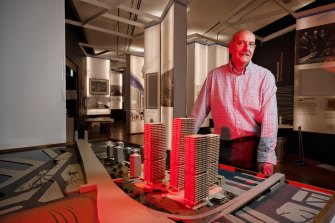Sydney’s The Rocks was set to be razed in the early 1960s to make way for a Brutalist-style complex of up to 40-storey high-rise apartments catering to office workers and “middle-class families” spread across treeless podiums above street level.
Its colonial history was saved from the wrecking ball when developer James Wallace Pty Ltd couldn’t afford to buy existing properties for redevelopment, said Professor Rob Freestone, the curator of a new exhibition called unrealized sydney opening on Saturday.

Professor Rob Freestone, the guest curator of a new exhibition at the Museum of Sydney, stands in front of a model of a proposal that would have razed all of the Rocks. It didn’t go ahead because the company that won the tender couldn’t afford to buy all the properties needed for redevelopment. Credit:Nick Moir
The exhibition at the Museum of Sydney includes other visions of anonymous high-rise precincts that Freestone said were part of a mission to remove heritage and workers’ terraces from Woolloomooloo to Macquarie Street.
Other plans that never got off the drawing board included a multi-storey car park fronting the entire length of Circular Quay; an Opera House in the Domain; and plans for a Discovery Village at Darling Harbor that recalled the 1960s TV show The Jetsons with a futuristic dome.
Freestone, a professor of city planning at the University of NSW School of Built Environment, said an important takeaway from the new exhibition was “beware of high rise”. That’s particularly the case when tall buildings are proposed in precincts that don’t have them already, such as the now moderated plans for Blackwattle Bay.
The exhibition includes official and unofficial plans, competition entries, unsolicited proposals, design challenges and ideas festivals for major projects.
Planning and construction after World War II was promoted by governments as a way of providing for years of prosperity and progress, Freestone said.
“Brave-new-world thinking brought with it new and revived utopian visions of rebuilt cities sweeping away slums, congestion and other unwanted legacies from the past,” he said. “The years after World War II saw complete replanning of precincts, not just buildings, on a scale that increased into the 1960s.
“Alongside the proclaimed technological and mobility advancements came serious community resistance for the first time in Sydney… We have fortunately taken some learnings from past disaster.”
